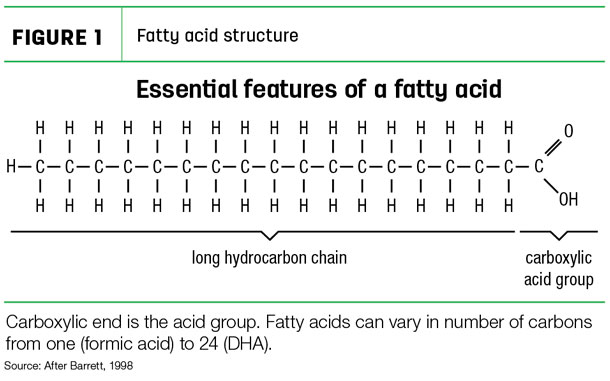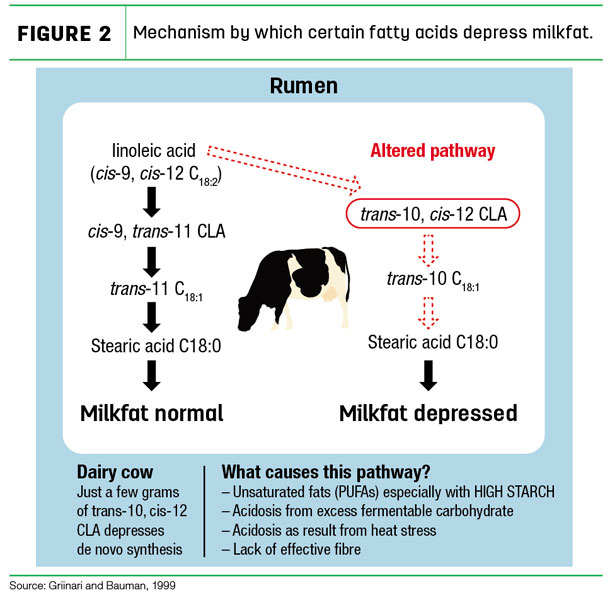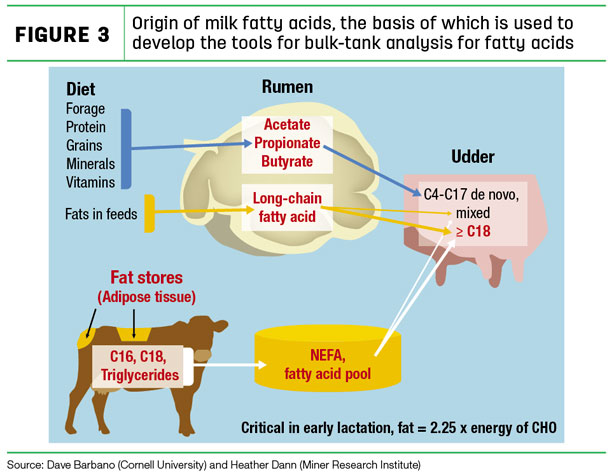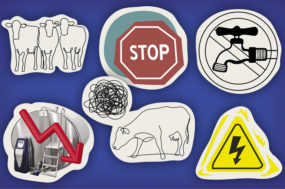Outside of total milk yield, it is most affected by feeding, management and environmental factors. It is therefore not surprising much effort has been devoted to better understanding the mechanics of butterfat production.
While producers pay attention and are compensated on the total fat produced, it is the composition of the fat itself today’s research is focused on.
Milkfat is primarily composed of fatty acids linked together to a molecule called glycerol. A fatty acid is essentially a string of carbon molecules that have a methyl end and an acid end (Figure 1).

Glycerol is a carbohydrate that is essentially half a glucose molecule. Each glycerol molecule has three branches to which a fatty acid is attached. This combination of one glycerol to three fatty acids is what is referred to as a triglyceride.
So milkfat is approximately 95 percent triglycerides, and the remainder is other minor components. There are more than 400 fatty acids, but only about 15 fatty acids make up the majority and dominate the nutrition field.
Our increased understanding of fatty acids and the role they play, not only for the cow and calf but also for human consumption, is changing the stigma on milkfat.
The ability to manipulate the fatty acid profile of milk allows for unique target market opportunities. One example is omega-3 fatty acids. Another is a group called the odd and branched-chain fatty acids.
So why be concerned about fatty acids? The answer is severalfold.
In the dairy cow, short-chain fatty acids, called volatile fatty acids, are the product of rumen microbial fermentation and serve as the major energy source in the dairy cow.
These volatile fatty acids are absorbed and converted to glucose (energy), and also are used to produce fatty acids in milk.
Fatty acids, up to 15 carbons long, all originate from rumen microbial action. There is also a small amount of 17-carbon fatty acids that originate from rumen microbial fermentation and a fair proportion of the 16-carbon-long fatty acids.
Some of these short-chain fatty acids kill pathogenic bacteria in the gut. Others, such as butyric acid, help in gut development. Butyric acid products are now common feed additives to help with gut development in young calves and other species like chicks and piglets.
The longer-chain fatty acids serve several additional functions in the dairy cow and in all mammals, including humans.
They are a key component of cell membranes, reproductive hormones, gene expression and are intimately involved with animal health and immunity (both from a positive and negative perspective).
Another unique aspect of fatty acids is: They can come in liquid (oil) or solid form. As chain length increases, the fatty acid tends to become hard at room temperature.
However, if a hydrogen is removed from the carbon in the fatty acid chain, it allows the formation of what is called a double bond in the fatty acid.
The formation of double bonds cause these fats to become liquid at room temperature. We call these fatty acids with double bonds unsaturated fats. Due to their liquid nature, they tend not to clog arteries and generally have a positive effect for human health.
Vegetable sources (e.g., soybeans, canola) tend to have more unsaturated fatty acids, so the fat from these sources tend to be oils. In the rumen, these oils will kill rumen bacteria, and this is why they are limit fed in dairy cow diets.
Role in fat depression
Fatty acids can also have the same fatty acid length and the same number of double bonds, but the hydrogen ions attached to the carbon can lie on different sides of the carbon (below or above). This orientation is called “cis” or “trans.”
Mother Nature has made these forms of the same fatty acid (called isomers) to have totally different properties.
For instance, one isomer of a fatty acid that is 18 carbons long and has two double bonds (conjugated linoleic acid – CLA) can cause severe fat suppression in the dairy cow, whereas the other isomer of CLA that has the orientation another way has no effect on butterfat (see Figure 2).

Fatty acids responsible for fat depression are generated in the rumen. Dietary ingredients are the key factors influencing the production of these fatty acids.
Heat stress changes the feed behaviour of cows and can also promote these fatty acids. Nutritionists today are more aware of the ways to prevent the production of these fatty acids.
One tool is to assess the TMR for what is called a rumen-unsaturated fatty acid load (RUFAL), introduced by Tom Jenkins of Clemson University. The aim is to ensure RUFAL percentage stays below 3.5 percent of the total diet dry matter.
Bulk tank analysis
The fatty acid composition of bulk tank milk is now being used as a tool by nutritionists and dairy producers to find out what is happening inside the cow, in particular the rumen.
This work was initiated at Cornell University and at Miner Research Institute. The fatty acids present in milk originate from three primary sources (Figure 3).

One main source, as mentioned before, is short-chain fatty acids produced in the rumen. The udder of the dairy cow also has the chemical and enzymatic machinery to generate fatty acids, primarily up to 16 carbons in length.
Since these fatty acids are generated from new, they are referred to as “de novo” synthesized fatty acids. They are a major component of milkfat and can be up to one-third of the total fat found in milk.
The 18-carbon fatty acid implicated in fat depression essentially shuts down a major proportion of de novo synthesis.
It is not surprising to observe a decrease of more than 1 percent fat (from 4 percent to 3 percent) within a short period, when conditions are right.
For instance, if you feed unprotected fish oil (an unsaturated fat) at a dosage to exceed the recommended RUFAL level, the rumen bacteria would produce a higher quantity of the 18-carbon fatty acid isomer that causes a fat depression.
Besides the de novo fatty acid group, the bulk tank analysis also measures a mixed group and a long-chain group.
The mixed group is mainly fatty acids 16 carbons long that can come from rumen short-chain fatty acids but also from the diet and from the fat stores in the dairy cow.
The long-chain group comes primarily from the diet and fat stores and is comprised of fatty acids over 18 carbons long.
Feeding fats
Some fatty acids can increase milk fat. Palmitic fatty acid is 16 carbons long and is a saturated fat. It appears to be transferred readily into milk butterfat, so palm fat products have become popular ingredients in many dairy cow diets, especially when fat suppression is occurring.
Until recently in Ontario, incentive days and increased quota led to increased scrutiny of feeding programs and feeding of palm fats.
In today’s more restricted quota environment, and with industry uncertainty, many producers have reduced the feeding of palm fats and other additives. However, palmitic fat carries some unique metabolic properties in the dairy cow, and research at Michigan State would indicate in early lactation dietary palmitic fatty acid would help promote some body fat mobilization.
So while butterfat levels will increase, the concern is an excess of this fatty acid can cause too much condition loss in the cow.
A combination of this 16 palmitic fatty acid along with an 18-carbon fatty acid (stearic) has been suggested to counteract the excess condition loss.
Stearic acid will also increase the fat content in milk. Many nutritionists now feed a source of both palmitic and stearic fatty acids to dairy cows (but the specific combination is important).
It is remiss not to mention one reason for adding fat to dairy cow diets is to counteract the energy deficit that occurs in early lactation (where dry matter intake peak lags behind milk yield peak), since fat sources usually provide approximately 2.25 times the energy of that from carbohydrate (e.g., grain).
Fat also has a lower heat increment and is beneficial during heat stress. However, these fat sources do nothing for rumen fermentation or to serve as nutrients for the rumen microflora.
Optimization of rumen function should always be a first priority prior to fat addition.
Bottom line
A discussion on the role of fatty acids from milkfat in dairy cows is not an easy topic. However, milkfat is the most complex of all the fats – primarily because of the over 400 fatty acids present in it.
While some of the unique properties of some of these fatty acids were highlighted here, no mention was made of the nutrigenomic effect of some of these acids.
The odd and branched-chain fatty acids in milk that were briefly mentioned are purported to have significant human health benefits.
As we find out more about these fatty acids, it is anticipated the golden value of milk will increase, and opportunities for the dairy industry will expand proportionally. ![]()
Author’s note: This discussion did not cover all of the feed and management factors that affect milkfat in the dairy cow. Anyone interested in a checkoff list can contact me or the editor of Progressive Dairyman.
Dan Ganesh works for Bos Nutrition Services Inc. Email Dan Ganesh.








